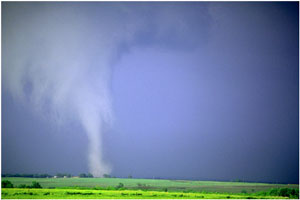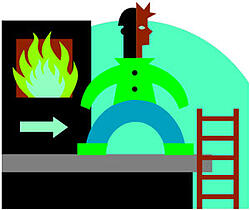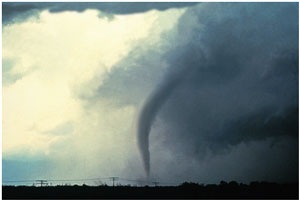 How do Pipes Burst?
How do Pipes Burst?
Contrary to popular belief, pipes do not typically burst where the ice blockage is located. The expansion of the ice against the wall of the pipe does not cause it to break. Rather, after a complete ice blockage in a pipe occurs, the continued freezing and expansion inside the pipe causes water pressure to increase downstream, between the ice blockage and a closed faucet at the end. This increase in water pressure is what causes the pipe to fail. Usually the pipe bursts where little or no ice has formed. Upstream from the ice blockage the water can always flow back towards its source, so there is no pressure build-up to cause a break. Water has to freeze for ice blockages to occur. Pipes that are adequately insulated along their entire length are usually safe from freezing.
Which Pipes are Susceptible to Freezing?
Generally, homes and structures in northern climates are built with the water pipes located inside the building insulation, which protects the pipes from subfreezing weather. However, extremely cold weather and holes in the building that allow a flow of cold air to come into contact with pipes can lead to freezing and bursting.
Pipes in attics, crawl spaces and outside walls are all vulnerable to freezing, especially if there are cracks or openings that allow cold, outside air to reach the pipes. Research has shown that “wind chill,” can accelerate the freezing process.
Holes in outside walls where television, cable, or phone lines enter can allow cold air to reach pipes. The size of pipes and their composition (e.g., copper or PVC) have some bearing on how fast ice forms, but they are relatively minor factors in pipe bursting compared with the absence of heat, pipe insulation and exposure to subfreezing air.
At What Temperature do Pipes Freeze?
When should you be alert to the danger of freezing pipes? That depends on the climate where you live, but the “temperature alert threshold” is 20 degrees F.
This threshold is based upon research conducted by the Building Research Council at the University of Illinois. Field tests of residential water systems subjected to winter temperatures demonstrated that, for un-insulated pipes installed in an unconditioned attic, the onset of freezing occurred when the outside temperature fell to 20 degrees F or below.
However, freezing incidents can occur when the temperature remains above 20 degrees F for an extended period of time. This is especially true if pipes are exposed to cold, flowing air, as on a windy day, due to cracks in an outside wall or lack of insulation. However, the 20 degrees F “temperature alert threshold” should be applicable in most cases.
 Suffering a disaster from a fire, flood or storm can be a traumatic experience for homeowners and their families. More often than not, the emotional trauma is linked to the loss of their personal belongings than it is to the damage to the structure. Usually, the reason for this is that people understand that the walls, ceilings and floors can usually be repaired to their original condition, or better. But sentimental belongings, keepsakes, and photos are often irreplaceable.
Suffering a disaster from a fire, flood or storm can be a traumatic experience for homeowners and their families. More often than not, the emotional trauma is linked to the loss of their personal belongings than it is to the damage to the structure. Usually, the reason for this is that people understand that the walls, ceilings and floors can usually be repaired to their original condition, or better. But sentimental belongings, keepsakes, and photos are often irreplaceable.
 One of the biggest concerns in the insurance industry today is “how to create a customer-focused organization”. This question forces insurance companies to take a closer look into their organization to identify where improvements can be made to increase customer satisfaction through better customer service performance.
One of the biggest concerns in the insurance industry today is “how to create a customer-focused organization”. This question forces insurance companies to take a closer look into their organization to identify where improvements can be made to increase customer satisfaction through better customer service performance. Large loss insurance claims that require the services of both an insurance restoration company and a general contractor can be a nightmare for many insurance agents and adjusters, as well as their claimants. This is primarily due to lapses in coordination, cooperation, and communication between the two companies and the insurer.
Large loss insurance claims that require the services of both an insurance restoration company and a general contractor can be a nightmare for many insurance agents and adjusters, as well as their claimants. This is primarily due to lapses in coordination, cooperation, and communication between the two companies and the insurer. Experiencing property loss due to a flood, fire or other disaster can be a very stressful and confusing event for the building owner. For that reason alone, it is very important that you choose a qualified restoration contractor who can answer any questions you have about the restoration process, to help alleviate your concerns. The project manager should listen closely to you and offer an open line of communication to guide you through the entire restoration process, without making you feel uncomfortable. This will ensure the project runs smoothly and gets completed on time, and to your satisfaction.
Experiencing property loss due to a flood, fire or other disaster can be a very stressful and confusing event for the building owner. For that reason alone, it is very important that you choose a qualified restoration contractor who can answer any questions you have about the restoration process, to help alleviate your concerns. The project manager should listen closely to you and offer an open line of communication to guide you through the entire restoration process, without making you feel uncomfortable. This will ensure the project runs smoothly and gets completed on time, and to your satisfaction. me home to find water has made its way into your basement. Typically, you’d start to move everything off the floor that could be damaged and anything that could possibly be salvaged, start baling water and call your insurance agent. Your agent, who you’ve been with since you bought your house 15 years ago, tells you your homeowners policy doesn’t have flood coverage. But you have homeowners insurance; isn’t that what it’s for?
me home to find water has made its way into your basement. Typically, you’d start to move everything off the floor that could be damaged and anything that could possibly be salvaged, start baling water and call your insurance agent. Your agent, who you’ve been with since you bought your house 15 years ago, tells you your homeowners policy doesn’t have flood coverage. But you have homeowners insurance; isn’t that what it’s for? If you listen, you hear complaints all the time from friends and family about customer service when buying goods and services:
If you listen, you hear complaints all the time from friends and family about customer service when buying goods and services:

 The storm has passed. No one was hurt. However, the house wasn’t so lucky. “Now what do we do?”
The storm has passed. No one was hurt. However, the house wasn’t so lucky. “Now what do we do?” 